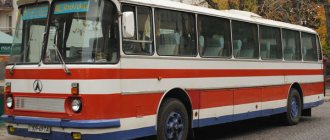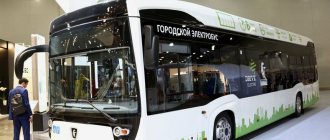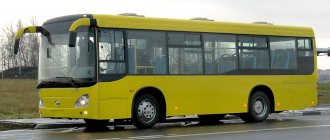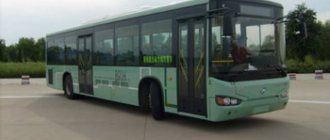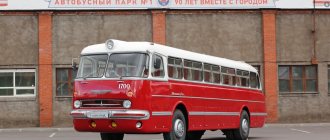Catalog > Likhachev Plant (ZIL, AMO) > ZIS-8
ZIS-8S ZIS-16S ZIS-44 ZIS-17 ZIL-158A ZIL-158D ZIS-129 ZIL-119A “Youth” ZIL-325010-12 ZIL-325000-12 ZIL-325000-13 ZIL-32502M 1926
: AMO-F15
1932-1934
: AMO-4
1934-1936
: ZIS-8
1938-1941
: ZIS-16
1947-1948
: AKZ-1 / ZIS-AMAREMUZ
1947-1950
: ZIS-154
1949-1957: ZIS-155
: ZIS-155
1955 - 1959
: ZIS-127
1956 - 1959
: ZIL-158 (LiAZ-158)
1959
: ZIL-159
1962 - 1970
: ZIL-118 “Youth”
1965
: ZIL-118A “Youth”
1971
: ZIL-119 “Youth” (ZIL-3207)
1999 - n.d.
: ZIL-3250 / ZIL-325000
2000 - n.d.
: ZIL-32501 / ZIL-325010
DescriptionHistoryPhoto galleryLinks
Go to photo gallery Go to photo gallery
ZIS-8 city bus photos characteristics 1934-1936.
Technical characteristics of ZIS-8
Equipment of ZIS-6 truck
ZIS-8 body
ZIS-8 in cinema
ZIS-8 is a Soviet city bus on the long-wheelbase ZIS-11 chassis (extended from 3.81 m to 4.42 m in the ZIS-5 version), produced at the Moscow Automobile Plant named after. Stalin from 1934 to 1936. Number of seats - 22 (total number of seats - 29).(wiki)
photo ZIS-8 city bus
The ZIS-8 bus was designed on the basis of the already existing AMO-4 city bus of 1932 of the “new standard” or “standard” type, the body of which remained virtually unchanged. Changes affected the chassis - the frame had to be strengthened with overlays on the side members, since the base of the bus was lengthened from 3.81 m. up to 4.42m. Hydraulic brakes at the front have been replaced by mechanical ones. A new driveshaft with articulated joints was installed, and the fuel tank was increased to 105 liters. Electrical equipment became 12 V.
The bus body frame was made of various types of wood and covered with metal sheets. All body parts - sides, walls, doors, roof and floor - were prepared separately, and then the frame was completed. The rigidity of the elastic suspension elements did not change depending on the load, so the empty bus did not have normal stability. Buses were also built on the ZIS-5 chassis (shorter in comparison with the AMO-4), ZIS-5V, UralZIS-5, and even on the chassis of the first ZIS-150 after the war.
photo ZIS-8 city bus
photo ZIS-8 city bus
ZIS-8 was produced at the Moscow Automobile Plant named after. Stalin from 1934 to 1936. Due to the reconstruction of the Stalin Plant in the second half of 1936, the production of ZiS-8 buses had to be stopped. However, according to the plant’s drawings, bus depots and body shops in Leningrad, Kyiv, Kharkov, Rostov-on-Don, Tula, Kaluga, Tbilisi, Irkutsk themselves manufactured bus bodies, mounting them on ZIS chassis. Such production was spontaneous and uncontrolled; most enterprises completely lacked technical documentation and drawings for production; buses had to be made according to. Often the machines assembled by these enterprises did not have any designation. Some factories tried to improve the design of the ZiS-8. Thus, in Tula, Kaluga and Leningrad, cars were produced with a body that was more streamlined than the ZiS drawings provided for. At the end of 1936, the second auto repair plant of the Lensovet Motor Transport Administration (ATUL) mastered the production of AL-2 buses with a 6x2 wheel arrangement, using an extended ZiS-8 frame and an additional beam axle.
Description and device
The ZIS-8 had a six-cylinder in-line carburetor engine with a volume of 5.55 liters and a power of 73 hp, which allowed the bus with a gross weight of 6.1 tons to accelerate to 60 km/h. Structurally, the ZIS-8 differed little from its predecessor, the AMO-4 bus; the 1932 model body of the “new standard” or “standard” type remained without significant changes.
Bus ZIS-8. Photo Wikipedia
The main changes affected the chassis - the frame began to be reinforced with a lining along the side members , the engine became more powerful due to the larger diameter of the pistons (101.6), the hydraulic brakes at the front were replaced with mechanical ones, in addition, a new driveshaft with articulated joints of the “Spicer No. 500” type and with additional support. Changes to the chassis were common to all ZIS trucks, including bus chassis. The new bus received an enlarged fuel tank (110 liters instead of the previous 60), a larger capacity radiator and a 12-volt electrical system.
The body with a wooden frame , made of different types of wood, sheathed in metal, was built according to the design of the designer N.I. Frantsev and the ZIS artist I.F. German. They used a ZIS-5 chassis extended by 610 mm. base. In contrast to the then-accepted artisanal practice of manufacturing a wooden frame in the form of a non-dismountable cage, Herman proposed making “assembled” frame elements for the ZIS-8, and then making a whole assembly from them. The sides, back and front walls, doors, roof, and floor base were made separately and then assembled together. This solution greatly simplified and reduced the cost of assembly.
The ZIS-8 had nickel-plated bumpers , and an illuminated route indicator was placed above the windshield. In addition to the main modification, there was a “Lux” version with a different interior layout - leather upholstery and one entrance door. For the southern regions of the country there was a version with a folding fabric top .
The characteristics of the most common elastic suspension elements - springs, springs or torsion bars - are such that their rigidity does not change depending on the load. Therefore, the ZIS-8, crowded with passengers with spring suspension, walked along the road quite smoothly, while the empty car was tossed on the uneven roads, like a boat on the waves. The harsh springs, without shock absorbers, made driving on cobblestone roads unpleasant.
ZIS-8 buses became the first Soviet exported buses. In 1934, a batch of 16 vehicles “left” for Turkey, where the first batch of Soviet export vehicles—100 ZIS-5 trucks—arrived a little earlier.
Options and modifications
- experimental 32-seater cabover bus - manufactured in 1937 on an extended ZIS-8 frame; the steering wheel, front axle and front springs were taken from the YAG-4 truck;
- experimental ZIS-8 with a natural gas engine - manufactured by the Automotive Research Institute. Fuel supply in 16 aluminum cylinders with a volume of 3 cubic meters. each was placed on the roof and provided a highway range of 90 km. (when refueling with lighting or coke oven gas) up to 170 km. (when refueling with high-calorie petroleum gas);
- veterinary care vehicle on the ZIS-8 chassis - two vehicles were manufactured in 1939;
- Intourist - a batch of luxury buses with improved interior trim for the Intourist military establishment (1934). The high level of qualifications achieved by the ZIS bodybuilders made it possible to build the experimental ZIS Lux in 1934 on an extended three-axle chassis of the ZIS-6 truck. It had a wheelbase of 4420 mm. and the base of the rear bogie is 1080 mm, the length is 8540 mm. Its body was truly streamlined: sloping radiator grille and windshield frame, rounded upper front roof and rear wall, front fenders with skirts, recessed door handles. The cabin was equipped with 28 individual seats of the ZIS-4 Lux type. The machine was manufactured under the guidance of experienced engineer A.A. Evseev, who studied body-building skills back in the pre-revolutionary years in France.
- ZIS-8 produced by the Leningrad plants VARZ and ATUL , in 2- and 3-axle versions, with standard and streamlined bodies.
There were also experimental gas generator buses ZIS-8, including those with a trailed trolley where the gas generator was located. The Moscow Research Institute of Urban Traffic developed prototypes of a passenger trailer with a capacity of 14 people in 1936. The coupling was carried out like a tram, and the opening between the bus-tractor and the trailer, into which unwary passengers could get, had parallelogram-type fences.
The meeting place cannot be changed ZIS-8
photo ZIS-8 city bus
Many people remember one of the characters in the film “The Meeting Place Cannot Be Changed” - a bus nicknamed “Ferdinand”. Despite the striking resemblance to the ZIS-8, unfortunately, this bus is a perfectly made copy of the legendary ZIS-8 car, made especially for filming, which for some time even after the filming was located in Kaliningrad near Moscow (now Korolev). The bus in general resembles the ZIS-8 serial vehicles produced in the pre-war years, but it is assembled on a chassis from a regular ZIS-5
, and not on an elongated frame,” says Mikhail Egorov, deputy director of the Mosgortrans Museum, in the explanation. — Therefore, the proportions are broken, and the body of the “Ferdinand” is not “native”. It even differs in size from those of the real ZIS-8, not to mention the details of the passenger compartment. This “cinema” car was made at the request of Mosfilm in Moscow. M. Egorov was able to find in factory documents dating back to the early 1960s a strange entry in the column about accounting for manufactured products: “ZIL-8” - 1 piece. Well, the replacement of the letter in the name is understandable - “Stalinist” names were eradicated everywhere. Another question remains: by that time, more than 15 years had passed since such vehicles were taken out of service, so who could need a “fossil” bus? Only film studios for filming films “about antiquity”. And later this car became famous, appearing in the TV series “The Meeting Place Cannot Be Changed.”
photo ZIS-8 bus interior
photo ZIS-8 city bus
photo ZIS-8 city bus
Basic characteristics
- Body dimensions, mm. (LxWxH). 7384x2200x2750.
- Ceiling height in the cabin, mm.
- Number and dimensions of doors. The body received four doors, the entrance double door was located at the back, on the opposite side. The limousine-style exit door was controlled from the driver's seat. The driver's entry door had a sliding glass. The fourth, emergency door was located in the rear wall of the body.
- Total number of seats, including landing seats. 29, including boarding 21+1.
- Lighting. For lighting at night, the body had five lampshades with 15-watt bulbs. In the front part, a lantern with two 25-watt light bulbs was installed on the wind frame. And on both sides of the route lamp there are two signal lamps with 10-watt lamps. The body lighting was controlled by two switches to the left of the instrument panel, one for the interior lighting of the bus, the second for route lamps and signal lights. Due to the increase in electricity consumption for additional lighting devices, the bus had to use a higher-power generator with a voltage of 12 volts and more capacious batteries located on the left under the floor of the body on special brackets attached to the left side member of the frame.
- Driver's cabin. The driver was separated from the passenger compartment in a special cabin with a separate entrance. A signal bell from the conductor was installed in the cabin.
1920s
In 1922, the Moscow City Council began negotiations with foreign companies about the purchase of buses. In parallel, work was carried out to organize our own production in collaboration with engineers from Fiat, Bussing and several others. Bureaucratic problems made it possible to open the first route only in 1924. It was served by only 8 buses produced by the English Leyland plant. Each could accommodate up to 60 standing and seated passengers. At the same time, the models were economical - gasoline consumption did not exceed 5 l/h at a maximum speed of 30 km/h.
Assembly shop AMO-F15
In 1925, engineers of the Automobile Moscow Society (the future ZiL plant) presented their first bus, the AMO-F-15. It, of course, bore little resemblance to modern ones. The developers took the truck of the same name with a 4-row engine producing 35 hp as a basis. s., carburetor, 4-speed manual transmission and right-hand drive. The first samples were open, designed for 10 passengers. Naturally, they could only be used in the southern regions of the Soviet Union, where there is no frost.
In 1926, the AMO-F15 received a roof
In 1926, the bus was modernized by installing a roof and increasing the number of seats for passengers to 14. But the model did not gain much popularity. Firstly, it could not compete with English buses in terms of capacity. Secondly, there was no talk of any comfort, either for passengers or drivers. The first ones almost flew around the cabin on uneven roads, and the drivers had stiff backs and sore hands during trips.
At the same time, Soviet regular bus service was finally opened in St. Petersburg, which changed its name to Leningrad. German Fomag models came on line. It is noteworthy that the bodies for them were made in the USSR. Then the local authorities decided to purchase Leyland, which had taken root in Moscow.
Ya-3 received the nickname "Leyland-Moscow"
But already in 1927, the first attempts were made to create a domestic bus of large (by those standards) capacity. The already familiar “Automobile Moscow Society” puts a body with seats for 22 passengers on the chassis of a three-ton Ya-3 truck from the Yaroslavl plant. In fact, it was a copy of the English model, for which it received the nickname “Leyland-Moscow”.
After 2 years, engineers try their hand at a new chassis from the five-ton Ya-5 truck. The driving force in the bus, called Ya-6, is a 93.5-horsepower Hercules engine. As a result, the cabin can accommodate 27 seated and 8 standing passengers. At the same time, several workshops produce bus bodies at once. That is, the chassis went to the cities, where local factories used them to manufacture passenger compartments. However, a significant problem soon emerged - the bus’s braking system could not cope with the tasks. And the turning radius of 9 meters did not allow the car to be operated at narrow intersections. In addition, the models had high consumption - 45 liters per 100 km. Nevertheless, the buses of this series were modernized. True, by the forces of repair shops, where broken cars were sent. So, in 1935, the Ya-6 No. 102 (the first and only model at that time) appeared with a streamlined body shape and a gramophone inside. Now the passengers rode to the music.
A total of 346 YA-6 buses were produced in the USSR
In total, the Yaroslavl plant produced 364 chassis to create the Ya-6 buses. Everything else was spent on building military and civilian trucks.
ZiS for MUR
0
Source:
See all photos in the gallery
Let's first debunk the legend that Gleb Yegorovich uttered his “thief should be in prison” precisely in the ZiS-8. As you know, the television series “Meeting Place...” was based on the Weiner brothers’ detective story “The Age of Mercy.” After digging a little on pirate sites, we find an interesting quote there: “In the courtyard near the dining room there was an old red and blue bus with a half-shabby inscription “police” on the side. Six-by-nine shouted to me: “Look, Sharapov, be surprised: the miracle of the century is a self-propelled bus!” It moves without human help... The captured Opel Blitz has probably seen its fair share of sights in its long life. Due to old age and the unbearably heavy load that he had to carry over many years, the springs sagged and the shock absorbers dried out, the car seemed to have fallen to the ground with a bulky, belly body on frail, patched cylinders, and with its clumsy body and flat, crushed muzzle, it looked like a huge sick bulldog.
0
Source:
Bus driver Kopyrin walked around the car, thoughtfully kicking the wheels, and shook his head with displeasure, not paying attention to the operatives’ teasing. He looked at me and, maybe because I wasn’t the only one laughing at his vehicle, he told me confidentially: “Eh, if only I could get two cylinders from a Dodge and put them in the back, the Ferdinand wouldn’t be worth it.” – Which “Ferdinand”? – I asked seriously. Kopyrin laughed: “Well, our fools, they christened the car, and now everyone calls it that.” Like, it looks a lot like a German self-propelled gun, the Ferdinand... ...Kopyrin climbed into the cockpit. He unlocked the passenger door with a long lever, once nickel-plated, but now peeled off to a copper green color and yet not losing its chic - a bent handle on a figured bracket.” What does this interesting fragment add to our knowledge? The simple fact that the Weiners pushed MUR workers into an Opel Blitz (its cargo version, by the way, we tested last year), there is no trace of a ZiS in this book. Yes, the movie is very different from the book, so it’s not even surprising that no one tried to find a captured Blitz for filming. However, it was also impossible to find the ZiS-8: the wooden body of the bus rotted completely within five years, so there were no living copies left by the time of filming. And so it turned out that a truly unique bus called ZIL-8 was filmed in the movie. There were only one of these cars produced... one of them! The one who was chasing the bandit Fox’s “student”. It is clear that the car was named ZiL because it was impossible to name anything after Stalin: it was the cult of his personality that they decided to condemn, so there could not be a ZiS. Actually, this ZIL-8 was supposed to represent the ZiS-8 on the screen, but for all its external similarity, it is very different from the ZiS. The real ZiS-8, the one we will drive today, although built on the chassis of the ZiS-5 truck, is significantly longer than the three-ton truck. Its length is seven meters, the base is 4.42 meters, while the length of the truck was six meters, and the base is 3.8 meters. The bus in the movie was built on the basis of the ZiS-5 and was significantly shorter than the original. And the body there is very dubious, so you’ll have to somehow continue to live with the idea that the bus of Zheglov and Sharapov is just a fake for filmmakers. But before our eyes stands, perhaps, the only real ZiS-8 in the world. It sounds pompous, of course, but you have to believe it. And to make this easier, let me tell you in a few words the history of the restoration of this bus.
×
"A city to remember." 543. Moscow bus. Story
January 15, 2022 Photo project “City in Memory”. 543. Moscow bus. Story
The first Moscow public transport was a horse-drawn cart with seats, which was called a line. The cart was replaced by a small light car - an omnibus, still horse-drawn, and then the evolution of the omnibus took place in two directions: if you put the car on rails, you get a horse-drawn carriage and a tram, and if you attach a gasoline internal combustion engine to it, you get a bus.
For quite a long time, the tram was out of competition and carried about 70% of all Moscow passengers, but in 1935, after the launch of the metro, it began to lose ground. In the same year, the General Plan for the Reconstruction of Moscow was adopted, which provided for the redrawing of a significant part of the city center, precisely where an extensive tram network existed (trams even ran along Red Square). With the expansion of streets and large-scale construction of new buildings, the rails served as a hindrance, and the much more mobile bus began to displace the tram tied to the rails and contact network.
Thus, the bus took a small revenge for pre-revolutionary oppression, when city authorities lobbied for the tram they owned, and the first private bus routes received only commuter services. In 1907, Count Alexander Sheremetev financed the launch of two open eight-seater Daimler and NAG buses from Maryina Roshcha to Ostankino, and in 1908, entrepreneur A. Buzinkov (Buznikov) launched four ten-seater buses on the routes Petrovsky Park - Pokrovskoye-Glebovo and Semenovskaya Zastava – Izmailovo menagerie. In the same year, the City Railways Administration decided to purchase one “self-propelled omnibus”, running it from Teatralnaya to Bolotnaya Square, but the car quickly broke down. The first-born of the automobile industry differed little from the lines in terms of comfort.
See old photos: Daimler bus in Ostankino. 1907: https://pastvu.com/p/103594
See old photos: Buses in Ostankino. 1911-1914: https://pastvu.com/p/79528
The birthday of the Moscow bus is considered to be August 8, 1924, when 28-seater English Leyland cars began running on the route Tverskaya Zastava - Kalanchevskaya Square. Transport workers received eight Leylands from England, and for their storage and repair the city allocated a site at the intersection of Bolshaya Dmitrovka and Georgievsky Lane.
The first Moscow bus fleet occupied the beautiful industrial buildings of Moscow's first Georgievskaya power station (1888, architect V. Sher), which by that time was outdated and closed. Today, the twice-remarkable building (the first power plant and the first car park!) houses the New Manege exhibition hall.
See old photos: Bus at Tverskaya Zastava. 1926-1929: https://pastvu.com/p/10443
The rolling stock was replenished with new Leylands, and by 1926 the garage could no longer accommodate all the buses, most of which slept in the open air. As a temporary measure, all cars were moved to a more spacious garage at Bolshaya Ordynka, 40 (architect M. Priyomyshev, the building has not survived) and at the same time they began to build a specialized bus garage in Maryina Roshcha.
Architect Konstantin Melnikov became interested in the problem of placing cars in a garage and came up with a parking method that later became known as the “direct-flow system.” In his sketches and drawings, the architect designated it as the “Melnikov system.” The meaning of this practical idea is to give up turning around and reversing cars; buses should enter the garage on one side and leave on the other. The Bakhmetyevsky bus depot in Maryina Roshcha was built in 1926-1927 and became one of the most recognizable projects of constructivist Konstantin Melnikov.
The equally famous engineer Vladimir Shukhov designed the trusses, spiral staircases and other metal structures of the building. In 1928, the architectural ensemble was supplemented by rectangular brick buildings for auto repair shops (the buildings were originally planned to be ellipsoidal) and the administration building.
See old photos: Leyland buses in the Bakhmetyevsky garage. 1930-1935: https://pastvu.com/p/8599
After the Great Patriotic War, the Bakhmetyevsky garage was renamed the 3rd bus depot and by the early 1960s it managed to operate 444 cars with an initially designed capacity of 186 buses. After the transport company moved to Bibirevo, the building was restored and is now occupied by the Jewish Museum and Tolerance Center.
In 1929, the duo of Konstantin Melnikov and Vladimir Shukhov, commissioned by Moscow utility workers, completed the design of another garage for trucks on Novoryazanskaya Street. Melnikov did not repeat himself and this time chose a horseshoe shape for the main body of the garage, and Shukhov calculated the supporting structures with a minimum of supports, which made it possible to place up to 250 large-sized trucks in the garage.
In 1948, the garage changed its specialization and the 4th bus depot was opened on its basis. 115 ZiS-8 and ZiS-16 buses were transferred here from the Bakhmetyevsky garage, and later the most popular models in Moscow, ZiS-154, ZiL-158, LiAZ-677, Ikarus-280, were operated in this fleet, serving up to 27 city routes. In 2014, the 4th bus depot was moved to Novokosino, and the building could be transferred to the Moscow Transport Museum.
The first bus depot was built in 1931 on the banks of the Moscow River on Druzhinnikovskaya Street. It was designed to operate 200 buses and had a separate building for maintenance and repair. In 1968, transport workers were transferred to Vorontsovo, and the construction of the House of Soviets of the RSFSR (House of the Government of the Russian Federation), better known as the White House, began on the vacated areas.
See old photos: 1st bus (Druzhinnikovsky) park. 1968: https://pastvu.com/p/35711
During the Soviet years, there were 18 bus parks in the capital, which were built mainly on the outskirts of the city or in industrial zones, in Kozhukhovo, Ochakovo, Chertanovo, Verkhniye Likhobory, on Varshavskoe Highway and in other areas. These were purely functional industrial buildings without any architectural flourishes.
The bus's peak demand came in the 1960s and 1970s, when the bus carried up to 35% of Moscow passengers, second only to the metro. This trend is explained by the development of the Moscow outskirts with prefabricated panel houses and the metro construction did not keep up with the growth rate of new residential areas. For example, the VDNH metro station remained the final stop until 1978 and all the northern districts of Babushkino, Sviblovo, Medvedkovo were served by buses, plus there were also the final stops of suburban routes to Mytishchi, Pushkino, Ivanteevka, Krasnoarmeysk, Sofrino.
Over the almost century-long history of gasoline public transport in Moscow, dozens of bus models of domestic and foreign production have been used. The flagship of transport engineering in the USSR was the AMO plant, built shortly before the October Revolution in Tyufelevaya Roshcha and nationalized by the Soviet government. The first one and a half ton truck AMO-F-15 was assembled in 1924 and soon went into production.
See old photos: Buses at the AMO plant. 1927: https://pastvu.com/p/21408
In 1926, on the chassis of the AMO-F-15 semi-truck, the first AMO bus was created, accommodating 14 passengers. Its body was made on a frame made of bent wooden profiles and sheathed in metal, the roof was covered with leatherette.
However, 175 English Leylands turned out to be so reliable and durable that city authorities were in no hurry to switch to “raw” domestic models and preferred imports from different countries. MAN, Büssing, FIAT, and Lancia buses managed to travel around Moscow. Then the government set a course for import substitution and the Moscow Soviet placed an order to the Yaroslavl Automobile Plant for the production of fifty I-6 chassis, on which other enterprises mounted bus bodies very similar to Leyland’s. The vehicles turned out to be unsuccessful in their performance, and by 1936 all the Yaroslavl vehicles were written off.
See old photographs: The main mechanical assembly building of the AMO plant. 1924-1929: https://pastvu.com/p/534832
Subsequently, Moscow focused on its own manufacturer: the enterprise in Tyufelevaya Roshcha had already changed its pre-revolutionary name AMO, increased its production capacity and became an automobile giant, known in the Soviet years as the Stalin Plant (ZiS), and later as the Likhachev Plant (ZiL).
From 1934 to 1936, the ZIS-8 city bus, designed to carry 21 passengers, was produced here. At stops, the driver manually opened the only door for entry and exit, and the conductor's duties included selling tickets. The body of the car was made of wood, covered with a thin sheet of iron, and the roof was made of canvas. A number of engineering solutions simplified and reduced the cost of assembly, so that bus production was established in other cities of the USSR, where bodies were made according to drawings and mounted on ZIS chassis. During the Great Patriotic War, the ZiS-8, repainted in green protective color, was mobilized for the needs of the front; a column of 40 Moscow regular buses took part in the evacuation of residents of besieged Leningrad along Ladoga. During the war years, the Moscow bus fleet lost 2/3 of its rolling stock; out of 1,230 pre-war vehicles, only 400 remained. In the cult television film “The Meeting Place Cannot Be Changed,” the ZiS-8, nicknamed “Ferdinand,” which carried Zheglov, Sharapov and their colleagues, was also painted in protective color.
See old photos: ZIS-16. 1946: https://pastvu.com/p/10444
The next success of the capital's automobile manufacturers was the ZIS-16 bus, produced in 1938-1941 and distinguished, in accordance with the then automobile fashion, by a streamlined body shape. A significant part of these vehicles after the war was reconstructed at an auto repair shop and replaced with new ZIS-150 chassis. Such measures allowed the ZIS-16 to be modified on suburban routes of the capital until the mid-1950s.
The AKZ-1 bus was produced at Aremkuz in 1947-1948
The auto body repair shop was founded in 1927 by the Trust of Moscow Transport Enterprises to repair and then manufacture bodies for Leyland buses.
The enterprise was located at a pre-revolutionary metal products plant on Kozhevnicheskaya Street and for several decades in its workshops prototypes were created, special bodies were manufactured, old cars were modernized and repaired.
See old photos: “Aremkuz”. LiAZ-677 buses in the workshop. 1970-1980: https://pastvu.com/p/90514
Since the 1960s, buses were brought here from all over Moscow to be repaired, and in the last years of its existence, Aremkuz was part of the structure of the State Unitary Enterprise Mosgortrans and carried out major and restoration repairs of LiAZ and Mercedes buses. Aremkuz played a significant role in the formation and development of urban transport, but times have changed and in 2005 the plant finally closed.
After the war, ZiS produced the ZiS-154 city bus with the first domestic serial all-metal carriage-type body. However, the new diesel engine was not fully developed and the car was discontinued.
See old photos: The main products of the car plant in 1956: https://pastvu.com/p/572989
The stylish ZiS-155 was produced from 1949 to 1957 and became the main model of bus fleets in the capital and other large cities of the USSR. In the intercity version of the ZiS-155, 15 seats were installed in the cabin, like on an airplane; these cars served passengers on the Moscow-Simferopol line.
And this yellow-green bus is a transitional model from the ZiS-155 to the ZiL-158, created in 1956 in several copies.
The next mass model was the ZIL-158 city bus; the factory workers produced the first pilot batch of 180 buses specifically for the VI World Festival of Youth and Students. Production of the car began in Moscow in 1957, but was soon transferred to Likino-Dulyovo, so on the hoods of seemingly identical cars you can see the emblems of either ZIL or LiAZ, and according to the documents the bus was labeled as “ZIL-158V produced by the Likinsky Bus Plant” . According to orders from the ministry, the Zilov workers transferred their successful and promising developments to other cities, which ultimately became one of the reasons for the collapse of the oldest automobile plant.
For a short time, road trains consisting of a ZIL-158 bus with a trailer, which the drivers nicknamed “nephew,” were also in use in Moscow.
See old photographs: Bus ZIL-127 in the Mechanical Engineering pavilion at VDNKh. 1958: https://pastvu.com/p/49851
The most innovative bus development of the Likhachev Plant was the ZIL-127 intercity bus, which in terms of body and interior design, passenger comfort and dynamic qualities corresponded to the best foreign analogues. The car went into production and was used on long-distance intercity routes from Moscow. But suddenly politics intervened in the automobile industry: the fraternal socialist countries wanted their piece of the pie in the market of the Council for Mutual Economic Assistance, and Hungary began producing large buses for the socialist countries. The ZIL-127 project was not further developed.
The intercity bus Ikarus-55 (1953-1961) is a product of the integration of the economies of socialist countries; it was manufactured in Hungary and assembled in the German Democratic Republic.
The first batches of four-door articulated Ikarus-180 arrived in Moscow in 1968; the bus trailer was connected to the tractor via a ball joint; both parts of the bus were connected by a dust- and moisture-proof vestibule covered with leatherette. Ikarus-180 received the nickname “accordion”, and for its large capacity it was called a “vacuum cleaner”.
Ikarus-256 on 3rd Magistralnaya Street
Ikarus-260 at the Museum of Industrial Culture
Together with Ikarus, the niche of intercity and tourist transportation was filled by Ukrainian LAZ buses, produced in the city of Lvov. LAZ-695 was developed in 1955 and became the first bus of the Lviv Automobile Plant, which previously specialized in the manufacture of vans, trailers and truck cranes.
Bus LAZ-695ESee old photos: LiAZ-677 in the 3rd bus depot. 1979: https://pastvu.com/p/20662
The most popular city bus was the LiAZ-677 produced by the Likinsky Bus Plant - about 194,000 copies were produced from 1967 to 2004. They were used in almost all regions of the former USSR. LiAZ-677 began to be designed in 1960. Even then, the location of the engine to the right of the driver was considered archaic, since the rear-engine layout, by reducing friction and reducing weight by eliminating the long driveshaft, allowed saving up to 25% of fuel. But it was precisely this arrangement of the engine that made it possible to repair it in some cases without leaving the cabin.
For a long time, the cost of travel on all types of ground public transport, from the line to the trolleybus, depended on the distance of the trip. At the entrance, the passenger paid money to the conductor and received a ticket. It turns out that the conductor profession existed for more than 100 years, until at the end of the 1950s, fares on buses and trolleybuses became fixed (in trams, this transition occurred earlier, during the Great Patriotic War).
By the way, a controller is also one of the oldest professions in transport; control over the “refunding” of passengers appeared in pre-revolutionary trams. During the years of “developed socialism” it was a shame not to pay for travel; after the monetary reform of 1961, a trip on a Moscow bus began to cost only 5 kopecks, and this tariff did not increase for almost three decades. It is unlikely that anywhere else in the world during these years there was such consistently cheap travel on public transport.
Since 1978, a modernized version has been produced - LiAZ-677M, distinguished by interior trim and an increased number of seats. The bus received a new engine running on “people's” A-76 gasoline and a newly designed brake system.Special models were also created on the basis of the LiAZ-677M, for example, a sanitary evacuation bus. The car is painted khaki, and instead of passenger seats, there are stretchers for victims in the cabin.
Moscow needed not only regular buses, but also service buses. In the garage of any large factory or research institute there were small passenger buses for transporting their employees. The most popular models were the PAZ-651 hood bus (1949-1973) on the GAZ-51 truck chassis and its successor with the PAZ-672 carriage layout (1967-1989). Soviet schoolchildren probably remembered the “groove” as an indispensable attribute of the summer pioneer camp. Modernizations with special bodies also came out of the gates of the Pavlovsk Bus Plant - an ambulance van, a television studio, a fire department headquarters, a hearse, and a food delivery van.
KAvZ-685 on the GAZ-53 chassis of the Kurgan Bus Plant
Resort bus-convertible KAVZ-651 “Ritsa”
Bus RAF-251
Boarding the PAZ-32053 bus on Pushkinskaya Square
See old photographs: Double-decker buses on Gorky Street. 1959: https://pastvu.com/p/80740
From 1959 to 1963, an experiment was conducted in Moscow with double-decker buses, which was considered unsuccessful due to the low speed, low maneuverability and poor stability of the tested Do56 and DoS6 vehicles produced by the German Democratic Republic.
And yet, double-deckers returned to Moscow as a shuttle bus for tourists, which travels to remarkable places in the city - the City Sightseeing excursion project started in 2012 with the support of the capital’s departments. The Chinese-made Higer Bus Company cars are painted red - the color of the famous London double-decker buses.
Most of the rarities have been preserved only in photographs, and the most widespread production cars can be seen in the collection of the Moscow Transport Museum. In 1954-1955, the buildings of Automotive Plant No. 4, which specialized in container cargo transportation, were built on Rogozhsky Val. In the farthest workshop there was a turning circle: a device typical of locomotive depots, but rare in motor transport enterprises. It can be assumed that the incoming car was directed by the dispatcher to one of the diagnostic points by rotating the turning circle. This made it easier to deploy the truck in a small space and not pollute the air with its exhaust. Later, this engineering device was laid and paved, but walking around the workshop, you can feel the vibration.
After the closure of the automobile plant, the building housed the Museum of Vintage Cars, which in 2016 changed its name to “Moscow Transport”. He began to combine an exhibition of foreign classic cars and the Soviet automobile industry with the extensive collection of Mosgortrans. The museum occupies five workshop-naves: in the first, rare passenger cars are exhibited, and in the following halls buses, trucks, fire engines and military vehicles of different years are housed. The bus doors are open, you can sit on the seats and examine the details of the cabin and interior.
You can see retro cars on the move during the traditional bus parades, which start from the Filyovsky bus and trolleybus depot and end at one of the squares in the city center.
In 1946, about 600 buses ran on 32 routes in Moscow, and now the register of bus routes passing through the territory of Moscow and served by Mosgortrans and Mostransavto includes over 1000 routes. However, due to the incredibly intensive development of the Moscow metro and the massive purchase of electric buses, the role of buses in intracity transportation is no longer so significant. According to media reports, the Moscow Government plans to completely abandon the purchase of new diesel buses in favor of electric buses from 2022.
Photos: Evgeny Chesnokov
All photo stories of the “City in Memory” project:
Category: Personal blogs. Tags: bus, city as a souvenir, walks around Moscow.
Other publications
Evgeniy Chesnokov 02.22.2022 at 20:39
"A city to remember." 709. From the village of Ostankino to the village of Marfino
In ancient times, forest thickets rustled on the northern outskirts of Moscow, and in the middle of the 16th century, two settlements were founded here - Ostashkovo (Ostankino) and Marfino.
Evgeny Chesnokov 12/19/2021 at 14:30
"A city to remember." 708. Museum of Cryptography
“The mission of the museum is to bring science back into fashion and explain that information security now concerns everyone.”
Evgeny Chesnokov 12/13/2021 at 18:34
"A city to remember." 707. Zelenograd - Moscow district remotely
Architect Igor Pokrovsky embodied in Zelenograd his vision of the style of Soviet modernism, reinforced concrete-brutal and at the same time intricate.
Evgeny Chesnokov 12/09/2021 at 01:06
"A city to remember." 706. Zelenograd and Kryukovo
The city under construction was reoriented to the development of electronics and microelectronics, similar to the Silicon Valley technology park in California.
Evgeniy Chesnokov 12/06/2021 at 03:08
"A city to remember." 705. Tretyakov-Ryabushinsky mansion
The main house of the city estate at 6 Gogolevsky Boulevard dates back to the second half of the 18th century, when Prince Pyotr Menshikov owned the land.
Evgeny Chesnokov 12/04/2021 at 18:31
"A city to remember." 704. Biryulyovo industrial and arboretum
During the Soviet years, a large industrial zone developed around the railway workers’ settlement at the Biryulyovo-Tovarnaya station.
Evgeny Chesnokov 11.29.2021 at 12:26
"A city to remember." 703. Biryulyovo and Zagorye
At the post station in the village of Biryulyovo, travelers could change horses and spend the night in a hotel.
Evgeny Chesnokov 11/14/2021 at 03:55
"A city to remember." 701. Olympic village and Nikolskoye village
The organizers of the 1980 Olympics took a pragmatic approach to the issue of housing the Olympians and planned a new residential neighborhood in Troparevo.
Evgeniy Chesnokov 11/01/2021 at 00:44
"A city to remember." 700. MKAD. 95-109 km. Losiny Island – Vostochny
In the 15th-17th centuries, Losiny Island was part of the Taininsky palace volost and was the hunting ground of Russian princes and tsars.
Evgeny Chesnokov 10/31/2021 at 02:34
"A city to remember." 699. MKAD. 93-95 km. Mytishchi – Friendship
On the 1860 map of Mytishchi there are only two rows of houses lined up on both sides of the Yaroslavl highway.
Evgeniy Chesnokov 08/04/2021 at 00:09
"A city to remember." 669. MKAD. 11-14 km. Kotelniki. Belaya Dacha – Silicate
Belaya Dacha, the main house of the estate in the former village of Pokrovskoye, was built in 1788 for Major General Nikolai Arshenevsky.
Evgeniy Chesnokov 07/27/2021 at 01:00
"A city to remember." 667. MKAD. 4-10 km. Novokosino – Zhulebino
Three lines of the Moscow Metro at once - Tagansko-Krasnopresnenskaya, Kalininskaya and Nekrasovskaya - crossed the Moscow Ring Road in the east.
Evgeniy Chesnokov 07.22.2021 at 21:13
"A city to remember." 666. MKAD, zero kilometer. Reutov
The Moscow ring road is a lot of asphalt, concrete, exhaust fumes and a complete lack of empathy for pedestrians.
Evgeny Chesnokov 07/09/2021 at 20:22
"A city to remember." 665. Behind the scenes of the Obraztsov Theater
Sergei Obraztsov's traveling theater initially traveled around the city in a van and gave performances in parks, squares, and schools.
Evgeniy Chesnokov 06.26.2021 at 02:22
"A city to remember." 663. From Khoroshevo to Krylatskoye
Any densely populated “dormitory” area of the Moscow outskirts a hundred years ago was a village or village.
Evgeny Chesnokov 06/09/2021 at 12:58
"A city to remember." 661. Academician Sakharov Avenue and Tsentrosoyuz
The laying of new highways was provided for by the Master Plan for the Reconstruction of Moscow, developed under the leadership of architects V. Semenov and S. Chernyshev in 1935.
